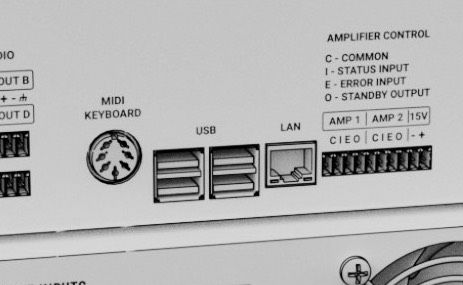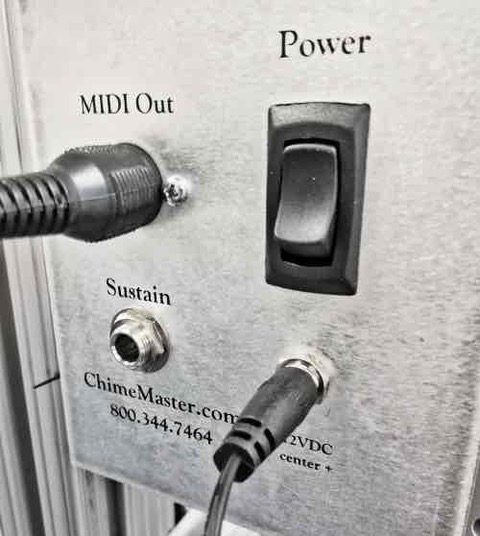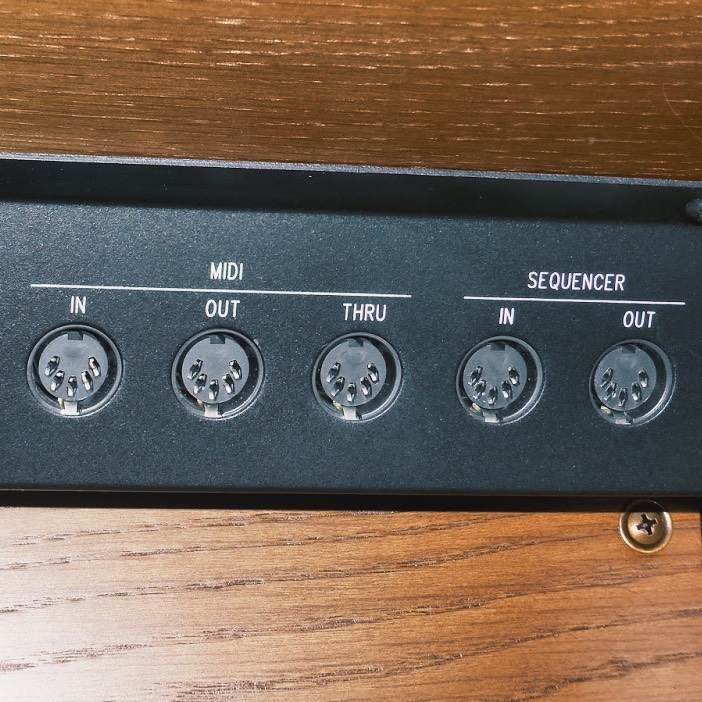Keyboard and organ connections: Difference between revisions
| Line 24: | Line 24: | ||
=== Organ MIDI interfaces === | === Organ MIDI interfaces === | ||
[[File:Organ-midi.jpg|frameless|right|300px]] | [[File:Organ-midi.jpg|frameless|right|300px|Typical organ MIDI connections]] | ||
Nearly all electronic organs manufactured since the late 1980s will feature a MIDI connection area, typically under the manual shelf. Connect the '''MIDI OUT''' socket to the cable running to the Chime Master system. | Nearly all electronic organs manufactured since the late 1980s will feature a MIDI connection area, typically under the manual shelf. Connect the '''MIDI OUT''' socket to the cable running to the Chime Master system. | ||
Revision as of 15:23, 10 December 2019
System keyboard inputs
MIDI Keyboard port
All Chime Master products that support MIDI keyboard connections will have a 7-pin DIN socket labeled MIDI Keyboard. The socket is mounted on either the rear panel of standard chassis or the bottom connection panel of wall mounted bell controls. The MIDI Keyboard input accepts standard MIDI 5-pin DIN plugs.
USB keyboard connection
Chime Master Advanced eXperience™ products support the connection of USB MIDI controllers, MIDI wireless extensions and MIDI to USB adapter cables to be connected to any free USB socket on the rear panel.
USB keyboards without DIN connections cannot be used on legacy Chime Master products.
Keyboard cables
Chime Master dedicated AGO keyboard
The Chime Master dedicated AGO keyboard has an attached cable with a 7-pin DIN plug on the end. The Chime Master system provides switched power to the keyboard when keyboard mode is selected. An indicator light on the high C key will indicate that the keyboard is powered.
No separate supply is required when the dedicated keyboard is connected to the system.
WCF carillon keyboard
The Chime Master WCF carillon keyboard has a 5-pin DIN socket for a MIDI output. It is supplied with a detachable cable with 5-pin DIN plugs on each end. You must also use the supplied AC to 12VDC power adapter with this keyboard.
Typical piano and synthesizer keyboards
Most electronic pianos will have a MIDI OUT socket that can be used with a standard 5-pin DIN MIDI cable.
Organ MIDI interfaces
Nearly all electronic organs manufactured since the late 1980s will feature a MIDI connection area, typically under the manual shelf. Connect the MIDI OUT socket to the cable running to the Chime Master system.
Pipe organ MIDI adapters may be found either on the organ console, or in the chamber. Your organ technician can help you determine if you have such an adapter and where it is.
Wireless keyboard extensions
The MIDI DIN plug cable carries what is known as a current loop interface. As cable length increases, the resistance of the cable reduces the current available at the input. This can cause missing or wrong notes to play.
Both wired and wireless extensions are available, and must be used if the distance from MIDI OUT to MIDI IN sockets exceeds 20 to 30 feet.
Wired extensions create a balanced signal that can be run thousands of feet over CAT5 twisted pair cable.
Wireless extensions convert the MIDI signal to a digital radio interface that can generally be used up to 500 feet line of sight.


